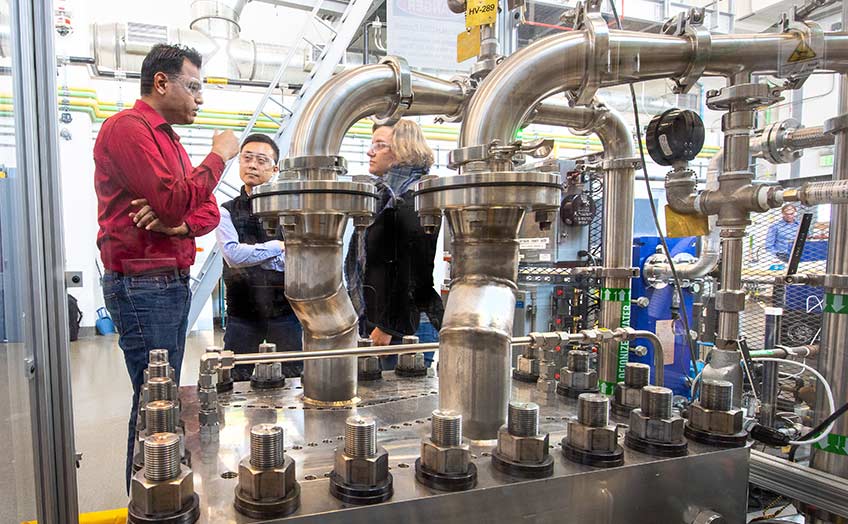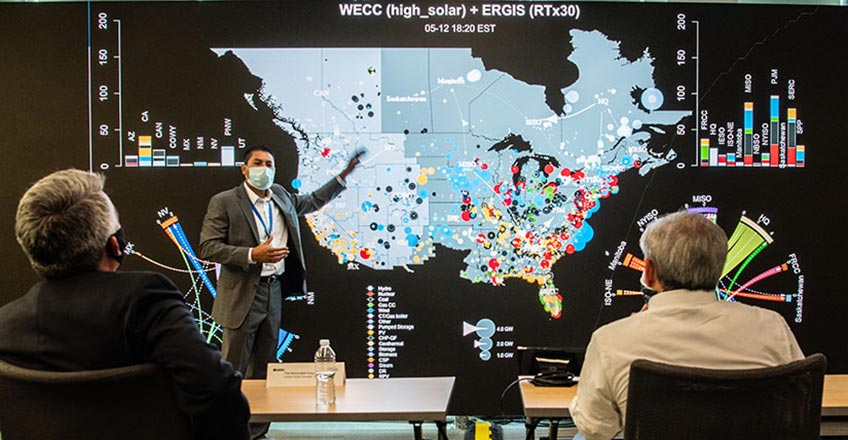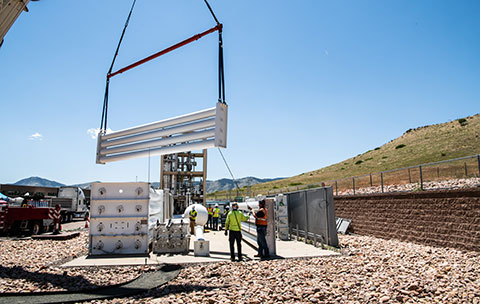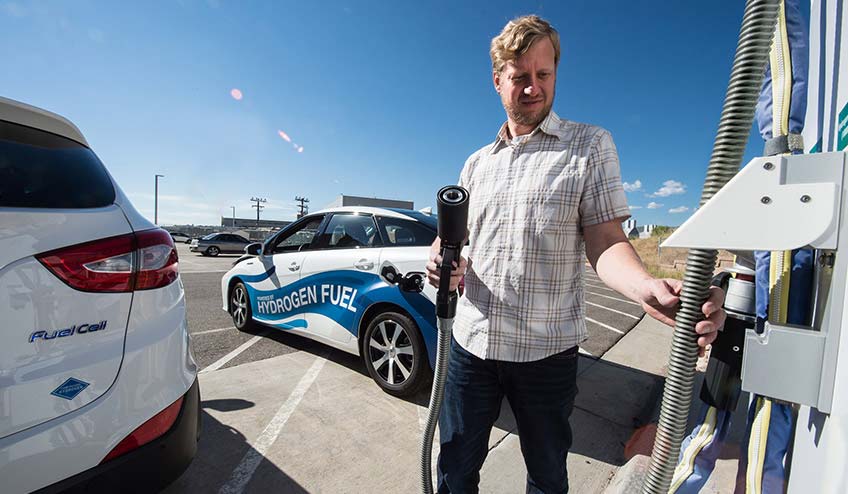NREL Celebrates a Year of Innovation on National Hydrogen and Fuel Cell Day
NREL Researchers Rishabh Jain, Kazunori Nagasawa, and Jen Kurtz are working on how
grid integration of electrolyzers—devices that use electricity to break water into
hydrogen and oxygen—could offset the grid impacts of extreme fast-charging. Photo by Dennis Schroeder, NREL
October 8—10/08—is National Hydrogen and Fuel Cell Day, a date chosen to represent the atomic weight of hydrogen (1.008). The U.S. Senate officially designated Oct. 8, 2020, as National Hydrogen and Fuel Cell Day with the passage of Senate Resolution 720, and Colorado’s governor issued a proclamation to proclaim the date as Hydrogen and Fuel Cell Day in Colorado. This is the sixth year in a row the Senate has passed such a resolution and the fourth year the State of Colorado has officially recognized the day.
This year, the National Renewable Energy Laboratory (NREL) is joining others in recognizing the day by celebrating the innovative research across the laboratory. Hydrogen has emerged as a leading energy storage technology, referenced by multiple in-depth techno-economic studies at NREL. In addition, NREL researchers are developing new state-of-the art specifications and facilities to evaluate hydrogen production, storage, infrastructure, and fuel cell technologies in support of the Department of Energy’s (DOE’s) H2@Scale initiative and NREL’s Electrons to Molecules and Integrated Energy Pathways research areas.
Here are some of the standout stories from NREL’s industry-leading hydrogen and fuel cell research.
In the Cyber Lab of NREL's Energy Systems Integration Facility, Juan Torres, NREL
Associate Laboratory Director for Energy Systems Integration (center), briefs Dan
Brouillette, U.S. Secretary of Energy (right), and Cory Gardner, U.S. Senator for
Colorado (left), on the newly launched Advanced Research on Integrated Energy Systems
(ARIES) platform. Photo by Dennis Schroeder, NREL
R&D Highlights
ARIES and RAIL Promise To Advance Renewable Energy Innovation and Integration
The recently introduced Advanced Research on Integrated Energy Systems (ARIES) program builds upon existing capabilities at ESIF and the Integrated Energy Systems at Scale (IESS) capabilities at NREL’s Flatirons Campus near Boulder, Colorado. ARIES will make it possible to understand the impact and get the most value from the millions of new devices—such as electric vehicles, renewable generation, hydrogen, energy storage, and grid-interactive efficient buildings—that are being connected to the grid daily. This program will allow researchers to provide real-time testing of equipment, including hydrogen electrolyzers, connected to the electrical grid at the 20-MW level.
Read the official ARIES and RAIL announcement.
Grid Coordination Opens Road for Electric Vehicle Flexibility
As electric vehicle sales continue to rev up in the United States, the power grid is in parallel contending with the greatest transformation in its 100-year history: the large-scale integration of renewable energy and power electronic devices. The changes will test the limits of grid integration, but NREL sees opportunity at the intersection of energy systems and transportation. One such opportunity is the use of electrolyzers to simultaneously produce hydrogen and improve voltage conditions.
Read more about the groundbreaking research into grid integration.
Hydrogen Has Great Potential for Seasonal Energy Storage
Hydrogen has the greatest potential among technologies for seasonal energy storage in the future, according to an analysis conducted by researchers at NREL. Seasonal energy storage can facilitate the deployment of high and ultrahigh shares of wind and solar energy sources, according to Omar Guerra, a research engineer at NREL and lead author of a new paper in the journal Energy & Environmental Science, "The Value of Seasonal Energy Storage Technologies for the Integration of Wind and Solar Power."
Read more about the energy storage opportunities within hydrogen research.
Lowering Atmospheric CO2 in Large-Scale Renewable Energy Electrochemical Process
What if carbon dioxide (CO2), a prevalent greenhouse gas, could be transformed into higher-value fuels and chemicals using low-cost, renewable electricity? Recent results from NREL may enable the scale-up of an electrochemical process to reduce CO2 that has not been possible until now.
Read more about NREL’s work to transform molecules such as CO2 into higher-value fuels and chemicals using low-cost, renewable electricity.

NREL workers, contractors and crane operators work on the new expansion upgrade of the Hydrogen Storage Pad at the ESIF. Crews repositioned existing equipment and added two new high-pressure hydrogen storage tanks. Photo by Dennis Schroeder, NREL
NREL Research into Fueling Big Rigs Could Help More Hydrogen Vehicles Hit the Road
Hydrogen-fueled cars are increasingly popular in California, but moving beyond the state's borders may require 18-wheelers crisscrossing America's highways leading the way. Research at NREL suggests a shift in long-haul trucking toward hydrogen that could drive a coast-to-coast network of fueling stations.
Read more about how hydrogen could transform heavy-duty trucking.
Declining Renewable Costs Drive Focus on Energy Storage
Declining costs in available technologies have propelled interest in energy storage like never before, and as communities and entire states push toward higher percentages of power from renewables, there is no doubt storage will play an important role. NREL's energy storage research spans a range of applications and technologies—including electrochemical storage, seasonal storage using hydrogen, grid-integrated stationary battery technologies, and storage for transportation.
Read more about the latest energy storage research into hydrogen, hydropower, and compressed air.
Get To Know the HydroGEN and HyMARC National Lab Consortia
The HydroGEN Advanced Water Splitting Materials consortium (HydroGEN) and Hydrogen Materials Advanced Research Consortium (HyMARC) were featured in the MRS TV video programming at the Materials Research Society (MRS) 2019 Fall Meeting in Boston, Massachusetts. HydroGEN, led by NREL, is accelerating research, development, and deployment of advanced water splitting technologies for clean, sustainable hydrogen production. HyMARC, co-led by NREL and Sandia National Laboratories, is accelerating discovery of advanced hydrogen storage materials and hydrogen carriers.
Learn more in the HydroGEN video and HyMARC video.
Matt Post fuels a Toyota Mirai and a Hyundai Tucson, two hydrogen fuel cell vehicles,
at the hydrogen fueling station at NREL's ESIF. Photo by Dennis Schroeder, NREL
New Data and Tools
Annual Technology Baseline Expands To Include Transportation Data
The first-ever Transportation Annual Technology Baseline consolidates U.S. vehicle and fuel technologies data for current and future markets through 2050, providing detailed cost and performance data, estimates, and assumptions for current and future vehicle and fuel technologies.
Read more findings from the Transportation Annual Technology Baseline.
New Hydrogen Filling Simulation Tool Drives Innovation for Fueling Stations
As hydrogen fuel cell electric cars and trucks grow in popularity, a new publicly available Hydrogen Filling Simulation (H2FillS) tool is laying the groundwork for the safe design of hydrogen fueling systems. NREL researchers, in collaboration with Kyushu University in Japan, designed H2FillS to answer vital questions about the change in hydrogen temperature, pressure, and mass flow when filling a hydrogen fuel cell car.
Read more about the development of H2FillS.
Staff Achievements
Hydrogen and Fuel Cell Technologies Office Recognizes Four NREL Researchers for Exceptional Contributions
DOE recently recognized three NREL researchers with annual program awards for invaluable contributions to hydrogen and fuel cell research.
- John Christensen, a subcontractor in NREL’s market transformation subprogram, was recognized for his invaluable contributions to the demonstration and deployment of hydrogen and fuel cell technologies within both military and civilian agencies of the federal government.
- Elizabeth Connelly was commended for her leadership of the 2020 Hydrogen and Fuel Cell Multi-Year Program Plan, rigorous techno-economic analyses in support of the H2@Scale initiative, and several key stakeholder workshops to advance progress worldwide.
- KC Neyerlin was recognized along with three other national lab scientists for their exemplary teamwork and technical prowess demonstrated in leading the ElectroCat consortium.
In addition, Luigi Osmieri was recognized as a runner up for a Postdoctoral Research Award for contributions to synthesize and characterize platinum-group-metal-free electrodes for fuel cells and electrolyzers.
Read more about the 2020 DOE Hydrogen and Fuel Cells Program awards and the postdoctoral recognition awards.
NREL Researcher Advocates for Hydrogen as a Clean Energy Alternative
Group manager and fuel cell researcher Bryan Pivovar was appointed an NREL senior research fellow in November 2019. Pivovar led the development of the H2@Scale concept beginning in 2015, bringing together several dozen staff members from across 14 DOE national laboratories to evaluate the potential of hydrogen across the U.S. energy system, and he helped grow the effort into DOE’s current H2@Scale initiative.
Read more about Pivovar’s legacy of hydrogen and fuel cell work at NREL.
Learn More
Celebrate Hydrogen and Fuel Cell Day your way with a list of suggested activities and resources from the DOE Hydrogen and Fuel Cell Technologies Office.
Learn more about NREL’s hydrogen and fuel cell research.

